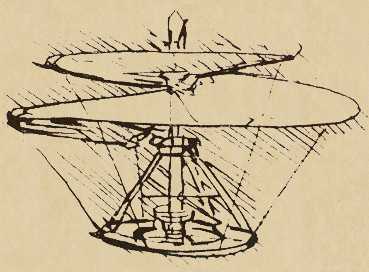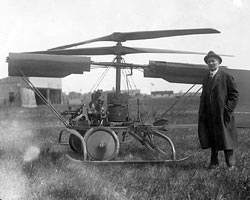History of Helicopters

The earliest type of flying machine for which there is definite evidence was a model helicopter invention. It resembled a small horizontal four bladed windmill, made to lift into the air by means of a drawstring wrapped round spindle.
The drawing of the model dates from about 1325, so it seems likely that the notion of the helicopter has fascinated aviation pioneers since before that date.
In about 1500 Leonardo de Vinci turned his mind to the helicopter invention, although he had no concept of true aerodynamic lift.
His drawing for a helicopter demonstrates its designer’s natural genius and could possibly have risen into the air if built as a model, but it was very eccentric.
Leonardo’s design was basically an airscrew in the literal sense of the word: a helical wing which if rotated would have ‘screwed’ itself up into the air.
VIDEO : Discovery Chanel – helicopter invention history
The trouble with this and with later designs was that although they might possibly have worked with models they were completely impractical for full sized helicopters because they ignored the problems of control, especially over the effects of the rotor’s torque. Like the aeroplane, the helicopter invention is based on the concept of aero-dynamic lift. But for the wings of a conventional aeroplane to achieve their lift, the whole machine must be driven through the still air.
With the helicopter, only the rotor blades are turned through the air and provide lift. The concept of helicopter flight, with the possibility of vertical take off and hovering, continued to exercise men’s thoughts in the centuries after Leonardo’s death, but though fascinating models a\were developed, the pioneers all lacked a true understanding of lift, as well as an adequately powerful and light engine.
Sir George Cayley drew up plans for a helicopter, and in 1842 W.H Phillips produced a fascinating model driven by a steam engine. The most interesting feature of the Phillips’ model were the steam jets issuing from the tips of the rotor blades to drive the lifting elements.
Only with the invention of the light petrol engine towards the end of the nineteenth century could the pioneers move on from models towards full sized machines. Here they came fact to face with the first basic problem of helicopter development: how to control torque reaction to the spinning rotor.

As the blades turn, the fuselage tends, by reaction, to rotate in the opposite direction. The pioneers saw several ways of overcoming this problem such as contra-rotating co-axial rotors, counter-rotating rotors on different shafts, or a small propeller mounted vertically at the rear end of the fuselage.
They could even suggest a practical means of moving the helicopter forwards, backwards and sideways. The axis of the rotor would be tilted to provide lift in the direction the pilot wished to take.
The problem that caused most difficulty in the development of fully practical helicopters, that of cyclic pitch control, was expounded by G.A Crocco in 1906. Rising vertically in still air, the speed of the airflow over all the blades of the rotor is equal.
But when the helicopter moves forward the air flows faster over the advancing blades of the rotor than over the retreating blades, thus giving uneven lift and tending to roll the helicopter over. The problem lay in finding how to adjust the blades so that the lift would be equal on both sides of the central shaft.
The solution – to alter the angle of the incidence of the blades as they turned – was fraught with technical problems and few engineers seemed to realise exactly what was needed. The odd and lonely figure of the Danish pioneer J.C Ellehammer who made interesting advances in the design of fixed wing aircraft, was perhaps the first man to build a helicopter with adequate provision for incidence control.
The machine was unsuccessful, however, and as with his fixed wing designs Ellehammer’s solitary way of life prevented his technical advances from becoming well known. But in 1912 two French helicopters had left the ground, although neither could be said to have flown in the proper sense of the word since neither had cyclic pitch controls or any other means of taking a direction in the air.
The first, in 1907, was built by the Breguet brothers. Powered by a 50hp Antoinette engine, the Breguet-Richet 1 rose into the air at Douai on September 29. Four men, one at each corner of the machine, had to steady the craft with long poles.
The distinction of building the free-flight manned helicopter must go to another French pioneer, Paul Cornu. His 25hp Antoinette powered twin rotor helicopter lifted its designed into the air, but only just, on November 13, 1907. Meanwhile the Breguet brothers, convinced that they were on the right track, persevered with their efforts, and in 1907 produced a developed form of their first machine: the Breguet-Richet II. Only July 22, the machine left the ground at Douai and then modified as the Breguet-Richet II-bis for exhibition in Paris.



मला हे helicopter तयार करायचे आहे मला माग॔दश॔ण पाहीजे आहे
TRANSLATION: I want to make this helicopter I want to guide.
I don’t know of any guides for this helicopter.